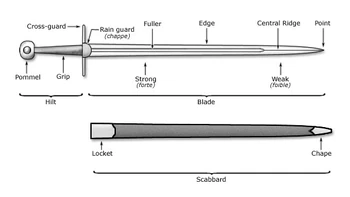Tag: Visual edit |
No edit summary Tags: Visual edit apiedit |
||
| Line 1: | Line 1: | ||
[[File:Sword Parts.jpg|thumb|350px]] |
[[File:Sword Parts.jpg|thumb|350px]] |
||
| − | '''Swords''' were one of the most common |
+ | '''Swords''' were one of the most common weapons in [[Alagaësia]]. There were many types of swords such as the [[hand-and-a-half sword]], [[Rider's sword]], [[rapier]], [[falchion]], [[flamberge]], and [[dagger]]. The [[Hûthvír]] is a staff/sword weapon. The person that wielded a sword often named it. The [[elf]], [[Rhunön]] was a well known swordsmith. The [[Ra'zac]] used swords. |
== Naming == |
== Naming == |
||
Revision as of 12:49, 24 May 2015

Swords were one of the most common weapons in Alagaësia. There were many types of swords such as the hand-and-a-half sword, Rider's sword, rapier, falchion, flamberge, and dagger. The Hûthvír is a staff/sword weapon. The person that wielded a sword often named it. The elf, Rhunön was a well known swordsmith. The Ra'zac used swords.
Naming
Swords throughout the Inheritance cycle are shown to have names, such as Zar'roc or Naegling. As Fredric mentioned, the sword of a famous warrior would almost always have a name. This was due to the fact that as the warrior gained fame, so did his weapon. The soldier's prowess in battle would be reflected upon his weapon. Therefore, a warrior's sword would be named whether or not the warrior wanted it. Either he would name it himself, or the bards would come up with a name for it. Either way, the sword's name would spread, the weapon becoming almost as famous as the soldier who wielded it.
Advantages
Swords were versatile and effective weapons on the battlefield. They could be wielded easily from foot or horseback, and were capable of engaging a myriad of enemies. The many different varieties of swords allowed swords to be used for a wide array of tasks and missions. Flamberges and broadswords could be very effective against heavy infantry and even cavalry, and long swords were very effective infantry weapons and side-arms. Compared to other weapons swords were relatively light and quick weapons, possessing greater mobility than spears or maces. Since they had both long blades and sharp points, swords could be used to slash, hack or stab enemies, unlike spears which were mainly for stabbing or axes which were mainly for hacking. Swords could be used offensively or defensively, and a skilled swordsman could use a sword for both purposes. Since swords could be carried in a sheath on the hip or back, they could also be carried as a secondary weapon, or as a backup.
Disadvantages
The main disadvantage when it came to swords was their short reach. Since swords were shorter than spears they were not well suited for engaging large groups of enemies or cavalry, as a swordsman had to get quite close to an enemy to engage him/her. Unlike spears or halberds, swords could not keep enemies at a distance, and a swordsman could be overwhelmed by multiple enemies. Most swords were also not particularly effective against cavalry, as a sword would have a harder time reaching a mounted soldier. However, the high mobility of swords made them good weapons for mounted warriors, and swords were very good for one-on-one combat.
Notable swords
- Zar'roc - wielded by Morzan, Brom, Eragon, and later Murtagh
- Naegling - wielded by Oromis
- Durza's sword - wielded by Durza
- Brisingr - wielded by Eragon
- Undbitr - wielded by Brom
- Arya's first sword - wielded by Arya
- Tamerlein - wielded by Arva , Naudra and later refitted for Arya
See also
| Weapons | ||||||||
|---|---|---|---|---|---|---|---|---|
|
